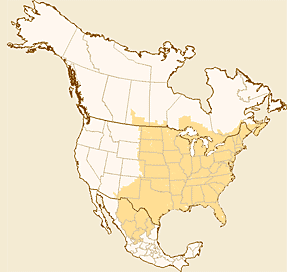Question Mark
Common Name: Question Mark.
Scientific Name: Polygonia Interrogationis.
What to look for? Look for a butterfly with orange and black colors, and some white speckles. The Question Mark Butterfly has a hooked forewing that is reddish-orange with black spots. It has two distinct seasonal upperside hindwing colorations: the summer form is mostly black with a short tail, while the winter form is bright orange with a longer, violet-tipped tail. The orange portion has irregularly shaped black-brown spots scattered across it. In stark contrast to the upperside colors, the underside is light brown. The Question Mark Butterfly gets its name from the pearly white question mark in center of the underside of its hindwing – a series of white speckles. The edges of the wings have a ragged, irregular appearance. The caterpillar or larvae form is usually a black, brown, or rust color with several yellow lateral lines, numerous orange branching spines on the body and a pair of black branching spines on the head.
Where can they be found at Carillon Stonegate Pond? The Question Mark Butterfly will be found here from May to September around some of our woodland areas.
How big are they? The Question Mark Butterfly has a wingspan of approximately two and one-half (2.5) inches. As a caterpillar, it can grow to nearly one and one-half (1.5) inches in length.
What are their flight patterns? Overwintered adult Question Marks are seen in flight during the spring, while the summer form emerges and flies during the summer months.
How else do they behave? Male Question Marks perch on branches, surveying their territory and scouting for females. They fly at passing butterflies and other insects, generally returning to the tree trunk or a nearby perch. Question Mark butterflies communicate through chemical methods.
What’s for dinner? Butterflies and moths have a different diet during their larval caterpillar phase than they do as winged adults. While Question Mark Butterflies do feed at milkweeds and asters for nectar; like other anglewings, they prefer to visit sap and rotting fruit to dine. In its larval form, caterpillars eat woody plants such as elm trees. They also feed on non-woody plants such as False Nettle and Stinging Nettle.
Where do they take up residence? The Question Mark Butterfly is found from the Rocky Mountains across to the eastern United States and southern Canada. They prefer areas with trees and some open space, such as riparian woodlands, city parks, suburbs, and agricultural areas.
When and where do they breed and nest? Remember the lifecycle of a butterfly: (1) eggs, (2) larval state as caterpillar, (3) pupa state in chrysalis or cocoon, and (4) butterfly. Question Marks live for only a few weeks, so their instinct is to mate. Males find females by perching on leaves or tree trunks in the afternoon. Females lay eggs singly or stacked under leaves of plants that are usually not the hosts. Caterpillars find a host plant shortly after hatching and emerging from the egg. In the chrysalis stage, it hangs upside down from twig and often resembles dead leaf. It pupates in approximately two (2) weeks, emerging as an adult Question Mark.
Where do they migrate? They are semi-migratory with some individuals traveling south for the winter, while others stay and hibernate.
Do they make any interesting sounds? No.
Interesting Facts About the Question Mark Butterflies:
-
The Question Mark Butterfly is not the only anglewing with “punctuation marks” on their wing: Eastern Commas and Gray Commas do also.
-
The undersides of their wings are camouflaged and resemble dead leaves, allowing them to hide from predators.
For more information on the Question Mark Butterfly and sources of information used in this blog (these are the several of the sources that I am using to learn as I blog), please visit Butterflies and Moths of North America, Butterfly Identification, University of Michigan’s Animal Diversity Web, and Massachusetts Audubon.
The Carillon at Stonegate community is very fortunate to have a variety of wetland, forest and prairie environments conducive to a variety of birds and other wildlife, insects and plants. Our community and the Kane County Forest Preserve do an exceptional job in maintaining this natural environment – both for the benefit of the birds and wildlife and for our residents to enjoy.
Take a hike and see what you can find – and identify!



